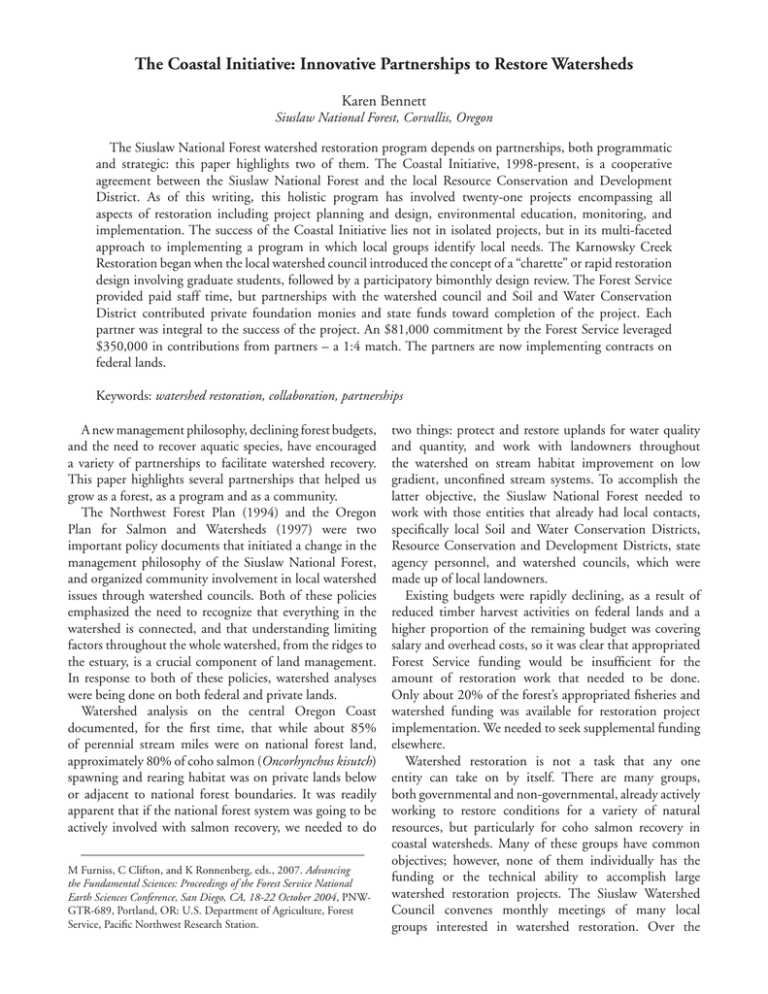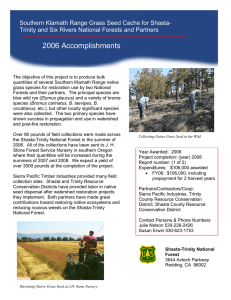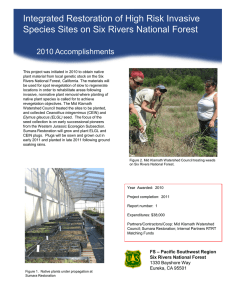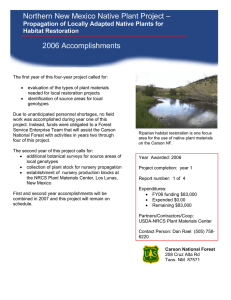The Coastal Initiative: Innovative Partnerships to Restore Watersheds Karen Bennett
advertisement

The Coastal Initiative: Innovative Partnerships to Restore Watersheds Karen Bennett Siuslaw National Forest, Corvallis, Oregon The Siuslaw National Forest watershed restoration program depends on partnerships, both programmatic and strategic: this paper highlights two of them. The Coastal Initiative, 1998-present, is a cooperative agreement between the Siuslaw National Forest and the local Resource Conservation and Development District. As of this writing, this holistic program has involved twenty-one projects encompassing all aspects of restoration including project planning and design, environmental education, monitoring, and implementation. The success of the Coastal Initiative lies not in isolated projects, but in its multi-faceted approach to implementing a program in which local groups identify local needs. The Karnowsky Creek Restoration began when the local watershed council introduced the concept of a “charette” or rapid restoration design involving graduate students, followed by a participatory bimonthly design review. The Forest Service provided paid staff time, but partnerships with the watershed council and Soil and Water Conservation District contributed private foundation monies and state funds toward completion of the project. Each partner was integral to the success of the project. An $81,000 commitment by the Forest Service leveraged $350,000 in contributions from partners – a 1:4 match. The partners are now implementing contracts on federal lands. Keywords: watershed restoration, collaboration, partnerships A new management philosophy, declining forest budgets, and the need to recover aquatic species, have encouraged a variety of partnerships to facilitate watershed recovery. This paper highlights several partnerships that helped us grow as a forest, as a program and as a community. The Northwest Forest Plan (1994) and the Oregon Plan for Salmon and Watersheds (1997) were two important policy documents that initiated a change in the management philosophy of the Siuslaw National Forest, and organized community involvement in local watershed issues through watershed councils. Both of these policies emphasized the need to recognize that everything in the watershed is connected, and that understanding limiting factors throughout the whole watershed, from the ridges to the estuary, is a crucial component of land management. In response to both of these policies, watershed analyses were being done on both federal and private lands. Watershed analysis on the central Oregon Coast documented, for the first time, that while about 85% of perennial stream miles were on national forest land, approximately 80% of coho salmon (Oncorhynchus kisutch) spawning and rearing habitat was on private lands below or adjacent to national forest boundaries. It was readily apparent that if the national forest system was going to be actively involved with salmon recovery, we needed to do M Furniss, C Clifton, and K Ronnenberg, eds., 2007. Advancing the Fundamental Sciences: Proceedings of the Forest Service National Earth Sciences Conference, San Diego, CA, 18-22 October 2004, PNWGTR-689, Portland, OR: U.S. Department of Agriculture, Forest Service, Pacific Northwest Research Station. two things: protect and restore uplands for water quality and quantity, and work with landowners throughout the watershed on stream habitat improvement on low gradient, unconfined stream systems. To accomplish the latter objective, the Siuslaw National Forest needed to work with those entities that already had local contacts, specifically local Soil and Water Conservation Districts, Resource Conservation and Development Districts, state agency personnel, and watershed councils, which were made up of local landowners. Existing budgets were rapidly declining, as a result of reduced timber harvest activities on federal lands and a higher proportion of the remaining budget was covering salary and overhead costs, so it was clear that appropriated Forest Service funding would be insufficient for the amount of restoration work that needed to be done. Only about 20% of the forest’s appropriated fisheries and watershed funding was available for restoration project implementation. We needed to seek supplemental funding elsewhere. Watershed restoration is not a task that any one entity can take on by itself. There are many groups, both governmental and non-governmental, already actively working to restore conditions for a variety of natural resources, but particularly for coho salmon recovery in coastal watersheds. Many of these groups have common objectives; however, none of them individually has the funding or the technical ability to accomplish large watershed restoration projects. The Siuslaw Watershed Council convenes monthly meetings of many local groups interested in watershed restoration. Over the BENNETT Figure 1: Six years of partnership funding on the Siuslaw National Forest. years, considerable trust and respect has developed among participants. Two or more partners often work together, drawing on the skills of each organization to accomplish shared restoration goals. True collaboration exists not when we seek approval for work we already have planned, attempt to get someone else to do our work for us, or tell someone else what they should be doing, but when the funding, skills, and advice of each group present combine to complete restoration assessments and projects efficiently and in a technically sound manner. The benefits of developing strong partnerships can easily be portrayed in economic terms. Through these collaborations, between 1999 and 2004, approximately $6.9 million was spent on restoration in the Siuslaw River basin (Figure 1). Direct USFS funding was only 7% of the total; another 28% was in USFS donated salary Table 1: Agreements and authorities available to Forest Service employees to facilitate partnership development. 507 and supplies (usually large logs for in-stream structures). Partners provided 66% of the funds for restoration with the single largest contribution (38%) coming from the State of Oregon Watershed Enhancement Board. Working with partners is a huge, long-term commitment, and it requires constant maintenance to succeed. For the Forest Service, internal commitment from the Forest Supervisor, the District Rangers, and the local district staff is essential for partnerships to succeed. And nothing can move forward without the involvement of the contracting and grants and agreement staff; their working knowledge of all the laws and regulations can either keep the process running smoothly or bring everything to a grinding halt. Often partners can apply pressure to ensure this internal support if you cannot obtain it yourself-don’t hesitate to ask them for help. A large variety of tools enable the Forest Service to work with the public and other agencies. First, natural resource specialists should have a working knowledge of all the internal authorities that allow the creation of various types of partnerships. Table 1 lists the agreements and authorities. It’s worthwhile to take training about partnership mechanisms, as knowing the ins and outs of those tools will allow you to help guide possible partners through the potentially-daunting paperwork required to set up the agreements. Make it as easy as possible for them to become involved by taking on the burden of the application process yourself. Ask someone to tell you more about the programs on this list if you think they may be appropriate for the project you want to implement. Second, there are many programs external to the Forest Service that are available for landowners, and often for federal lands if applied for through a partner, that can contribute funding for your projects. Table 2 lists some 508 THE COASTAL INITIATIVE Table 2: Programs providing potential external funding for watershed restoration projects. of the programs, many nation-wide, some state-specific. Find out what is available in your own area. A third critical component of watershed restoration is obtaining funding through grants. Hundreds of organizations have funding available for environmental restoration. However, there are a few things to know about writing successful grants. You stand a better chance of success if you make an effort to participate on boards of local non-profit groups, or volunteer to be on grant review teams, to develop honest and reliable relationships with potential backers. Get to know the source of funds for which you are applying, make a personal contact, explain your idea, and find out whether your project is something they are interested in before you begin to fill out the grant application. Invite potential funders out to your project site, along with your partners. Let your partners do the talking - they make a bigger impression. Then, if you get the grant award, be sure you do what you said you were going to do, make sure your project is technically sound, market the results and always give credit to the funding organization. Enough of the abstract: how about some real examples of successful watershed partnerships? The Coastal Initiative and Karnowsky Creek projects are two partnerships developed by the Siuslaw National Forest to accomplish a complex of watershed restoration projects in the Oregon Coast Range. THE COASTAL INITIATIVE The Coastal Initiative, a Cooperative Agreement between the Siuslaw National Forest and Cascade Pacific Resource Conservation & Development District, Inc. (CPRCD), has helped the forest develop outreach to existing local organizations and build capacity to further their on-going efforts. Through this agreement, the USFS supplied both analytical and technical project implementation skills while capitalizing on the contacts that already existed between landowners and these other local groups. The cooperative agreement and several amendments enabled us to have multiple on-the-ground restoration or outreach and monitoring projects active simultaneously. Twenty-one separate projects were included in the Coastal Initiative I 1998-2003. With the Coastal Initiative II 2004-present, fourteen projects are already authorized (Figure 2). The ability to amend the existing agreement on an on-going basis makes the initiative flexible and responsive to local community needs. The Coastal Initiative pools financial, technical, and social resources to accomplish its objectives. The project is economical and cost effective: with only a 10 % overhead charge, the CPRCD is responsible for project recruitment, landowner agreements, contracts, fiscal management, monitoring and reporting. BENNETT 509 Figure 2. Coastal Initiative sites and types of projects. Restoration of tidal flow onto an estuarine wetland that has been farmed for over 70 years improves salmonid rearing habitat. When we first began soliciting outside funding for projects, we found that the single greatest limiting factor in applying for grants is the inability to fund project designs-no granting group will pay for the design, yet they want to see the design before they will approve the project. The Coastal Initiative employed two successful methods to design projects. The first method provided a competitive grant to a local contractor to design stream restoration projects. The grant required the contractor to submit the final design (approved by the local watershed council technical team) in the form of a grant application. The first project of this type designed eight stream restoration projects for $8,000, which in turn brought in additional implementation grants amounting to $250,000. This project was not only successful in obtaining implantation grants, but also in increasing the project design capability of the local community. Since that initial grant, two more projects of this type have been authorized and are on-going. One unexpected benefit of this method is that local contractors are known and trusted in the community and they can often work with landowners whom state and federal agency personnel cannot easily approach. The second way the Coastal Initiative has found to accomplish project design is to hire an interdisciplinary team of graduate students for an eight-week internship managed by the local watershed council. This student-led project provided graduate students with the challenges of a real-life restoration design opportunity, working in cooperation with local community members and agency representatives (Figure 3). The students bring a freshness, enthusiasm, solid academic background, and phenomenal computer and graphic skills to the project. They respect local input, and through the interactive process of reporting back to an advisory committee every two weeks, they engage community interest and incorporate knowledge that agency staff might not have had time to gather. The 510 THE COASTAL INITIATIVE Figure 3. Students from the Mapleton Schools planting native plants from seeds they have collected and grown as part of the Natural Resources curriculum. Funding for the greenhouse came from the Coastal Initiative. final restoration project design is an easy-to-read document emphasizing graphic design, which is used as a marketing tool to acquire grants. The document content exemplifies the value of stakeholder involvement and partnerships in formulating a successful project design that engages community participation from concept through implementation. Two projects of this type have been completed under the Coastal Initiative. One project was successful in bringing in $450,000 for implementation of the plan; the other, still in phase one, was granted $125,000 for implementation within three months of the final design. In addition to the above-mentioned projects, the Coastal Initiative has included water quality monitoring, in-stream habitat improvement, education and outreach, fish passage improvement and riparian and tidal wetland restoration. All of these projects filled an important gap in funding to local communities, strengthened local programs, and accomplished technically sound watershed restoration. By being a part of these projects, the Forest Service has increased community trust and support, has been able to identify and propose local projects to restore watershed conditions, and has highlighted data gaps, particularly in the area of water quality. THE KARNOWSKY CREEK PROJECT Karnowsky Creek was purchased by the Siuslaw National Forest from a private landowner in 1992. When the Northwest Forest Plan was signed, it was apparent to the district that grazing land use occurring in the valley was not in line with current management direction. With encouragement of the Siuslaw Watershed Council, a group of students were brought in to develop a restoration strategy for the area. With the student-generated Karnowsky Creek Restoration design in hand, the watershed council and the Forest Service collaborated to develop a grant proposal for its implementation. The watershed council submitted the grant to the National Forest Foundation to fund the riparian restoration portion of the project, but a watershed council executive board member unexpectedly blocked submittal of the application to the State of Oregon Watershed Enhancement Board (OWEB), stating that he did not support state funding being spent on federal land. However, because the community was integrally involved with the design of the project from the concept phase onward, they felt great ownership in the project and wanted to see it move forward. The local Soil and Water Conservation District then submitted the grant to OWEB. The Forest Service didn’t even know these discussions were occurring, but the strength of community investment kept the project going. Both grants were successful in acquiring the funds needed to do the restoration work. Meanwhile the Forest Service completed the necessary environmental documentation. Each partner was integral to the success of the project: a true spirit of collaboration. In this project an $81,000 commitment by the FS leveraged $350,000 in contributions from partners for implementation - a 1:4 match. Implementation of the Karnowsky Creek restoration continued the unique partnership developed in the initial phases of the project. The Forest Service facilitated the necessary working agreements with the Siuslaw Soil and Water Conservation District (SWCD) and the Siuslaw Watershed Council, resulting in a Memorandum of Understanding that set up a Karnowsky Creek Board of Directors to enhance communications and oversee all activities that occurred within the Karnowsky Creek Valley. Participating agreements with the Siuslaw Watershed Council, the Siuslaw SWCD, and the Siuslaw National Forest enabled the partners to do projects on national forest lands. As a result, the watershed council hired a contractor and facilitated development of the riparian planting design, site preparation, planting, maintenance and monitoring of all riparian species. In addition, the SWCD hired a local contractor to do all road access, stream reconstruction and ditch filling, and hired a monitoring coordinator to facilitate local school involvement in project monitoring. A Forest Service employee was on site to inspect work done by the contractor. The collaboration has been phenomenal, each organization feels ownership in the work that has been done to restore Karnowsky Creek, BENNETT and we all acknowledge that the project would not have been possible without the enormous contributions of all involved. It takes innovation, enthusiasm and dedication to engage partners in a whole watershed restoration program. Personalities can be as varied as they are strong willed. Finding and working from common ground, forging alliances wherever necessary, and capitalizing on the skills and knowledge that each group and individual brings to the table is critical to success. The strong partnerships on the Siuslaw have been recognized internationally, receiving the 2004 Thiess International Riverprize for high quality river basin management. The Siuslaw National Forest will continue to be a part of the team that earned that recognition, in the interest of restoring watershed conditions, building strong communities, and fostering a positive relationship between local people and their environment. 511





